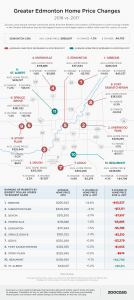Excess Supply in Edmonton Leads to Falling Prices in 2018
2018 was a rough year for the Edmonton housing market, with an excess of supply leading to slack prices and slowing sales.
Edmonton homes sold for an average of $369,600 in 2018, softening 1.3 per cent year over year. Single-family home prices decreased just 0.9 per cent to $434,000, while condos faced the steepest price drop, declining five per cent to 236,000 — this is in sharp contrast to Toronto and Vancouver condos for sale, and the national market as a whole, where apartment prices far outpaced other forms of housing.
Meanwhile, sales on the MLS Edmonton declined almost six per cent, to a total of 15,519 transactions, compared to 16,435 in 2017.
The dollar volume of sales was $5.73 billion, almost seven per cent less than 2017, representing a potentially steep loss for the local economy.
“The real estate market in 2018 experienced record-high inventory levels, rising interest rates, and the effect of the mortgage stress test, resulting in lower sales in all property categories,” says Michael Brodrick, chair of the Realtors Association of Edmonton. “It was a challenging market for both buyers and sellers and it appears 2019 will be similar.”
Developers have been overbuilding for years in Edmonton and without the natural borders of, let’s say, the coast of Vancouver or the greenbelt in the Greater Golden Horseshoe, sprawl is possible. Sprawl means more supply, more choice for buyers and ultimately a lack of pricing support.
On the other side of the supply coin is demand, and buyer demand has been seriously weakened by the tighter lending rules.
Borrowers’ income must now be able to support a mortgage of at least two percentage points above their contract rate or seek out a lender not under federal banking regulations.
With too much supply and too little demand, it’s inevitable that prices and sales will slide. The sales-to-new listings ratio is now at 47 per cent. Once it reaches 39 per cent it will be in buyer’s territory, meaning that sellers will be facing stiff competition in trying to get attention for their property.
For now, it’s still within the balanced range.
What’s most startling about Edmonton is how all neighbourhoods are mostly within lockstep — no neighbourhood posted significant gains and only one seriously plummeted in price.
St. Albert had the highest year-over-year price increase, with properties rising 1.2 per cent to $432,127 and Beaumont rising a similar 1.1 per cent to $438,656. Gibbons fell sharply, declining, 14.6 per cent year-over-year to $266,943.
Other neighbourhoods softened between 1-3 per cent.
Interested in Edmonton real estate? Get check out Alberta mortgage rates.
For more details on how each neighbourhood fared, check out this infographic below:
Zoocasa.com is a real estate company that combines online search tools and a full-service brokerage to empower Canadians to buy or sell their homes faster, easier and more successfully. Home buyers can browse homes across Canada on the website or the free iOS app.
Photo by Alex Pugliese on Unsplash
